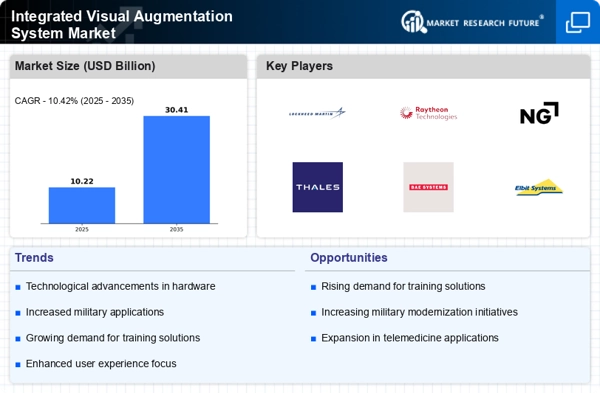Growing Demand in Healthcare
The Integrated Visual Augmentation System Market is experiencing growing demand in the healthcare sector, where these systems are being utilized for surgical assistance, medical training, and patient care. Augmented reality technologies enable surgeons to visualize critical information during procedures, thereby improving accuracy and outcomes. The healthcare market for augmented reality is projected to reach USD 2 billion by 2025, reflecting a strong interest in innovative solutions that enhance medical practices. This trend is driven by the increasing need for precision in surgeries and the desire to improve patient experiences. Consequently, the healthcare sector is emerging as a vital contributor to the growth of integrated visual augmentation systems.
Increased Focus on Training and Simulation
The Integrated Visual Augmentation System Market is witnessing an increased focus on training and simulation applications across various sectors. Organizations are recognizing the value of immersive training environments that augmented reality systems can provide. These systems facilitate realistic simulations, enabling personnel to practice complex scenarios without the associated risks. The market for training and simulation solutions is anticipated to grow significantly, with estimates suggesting a potential increase of 20% in demand over the next few years. This growth is largely attributed to the need for effective training methodologies in sectors such as aviation, healthcare, and military. As a result, integrated visual augmentation systems are becoming essential tools for enhancing training outcomes.
Emerging Applications in Industrial Sectors
The Integrated Visual Augmentation System Market is also witnessing emerging applications in various industrial sectors, including manufacturing, logistics, and maintenance. These systems are being employed to streamline operations, enhance productivity, and reduce errors. For instance, augmented reality can assist workers in assembly lines by providing real-time instructions and visual aids, which can lead to a reduction in training time and operational costs. The industrial sector is expected to see a CAGR of around 12% in the adoption of augmented reality solutions over the next few years. This growth indicates a shift towards more efficient and technologically advanced operational practices, positioning integrated visual augmentation systems as critical components in modern industrial environments.
Rising Applications in Defense and Security
The Integrated Visual Augmentation System Market is significantly influenced by the rising applications in defense and security sectors. Military organizations are adopting these systems to enhance situational awareness and improve combat effectiveness. The integration of augmented reality into soldier systems allows for real-time information overlay, which is vital for mission success. According to recent estimates, defense spending on augmented reality technologies is expected to reach USD 5 billion by 2026. This trend indicates a robust demand for integrated visual augmentation systems, as they provide critical advantages in tactical operations and training simulations. Consequently, the defense sector remains a key driver of growth in this market.
Technological Advancements in Augmented Reality
The Integrated Visual Augmentation System Market is experiencing a surge in technological advancements, particularly in augmented reality (AR) and virtual reality (VR) technologies. These innovations enhance the capabilities of visual augmentation systems, allowing for more immersive and interactive experiences. For instance, the integration of artificial intelligence and machine learning algorithms into these systems enables real-time data processing and analysis, which is crucial for applications in defense and healthcare. The market is projected to grow at a compound annual growth rate (CAGR) of approximately 15% over the next five years, driven by these technological enhancements. As a result, organizations are increasingly investing in AR and VR solutions to improve operational efficiency and decision-making processes.


















Leave a Comment